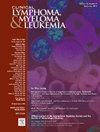The Evolving Role of Checkpoint Inhibitors in Multiple Myeloma
IF 2.7
4区 医学
Q2 HEMATOLOGY
引用次数: 0
Abstract
Multiple myeloma (MM) is a plasma cell dyscrasia characterized by production of abnormal levels of a monoclonal immunoglobulin or plasma cell deposition that leads to end organ destruction. The disease remains incurable despite advances in combination treatments with classes of medications that include proteosome inhibitors, immunomodulating agents, monoclonal antibodies, small molecule inhibitors, alkylating agents, T-cell-based immunotherapies, and others. Checkpoint inhibitors (CKP-I), though showing robust efficacy in solid tumor and lymphoma, have had limited success as single agents in the treatment of MM. Furthermore, early FDA holds on trials involving CKP-I in myeloma led to diminished enrollment and data on its potential use. Nevertheless, clearer understanding of the mechanisms of immune dysregulation and unique bone marrow biology in the pathophysiology of MM have opened the opportunity for future uses of CKP-I in multiple myeloma. Herein we provide a comprehensive review of the immunologic basis of multiple myeloma, preclinical and published data from trials utilizing CKP-I in MM patients, and future targets in CKP-I development that may provide promising opportunities in the treatment of MM.
检查点抑制剂在多发性骨髓瘤中不断演变的作用。
多发性骨髓瘤(MM)是一种浆细胞障碍性疾病,其特点是产生异常水平的单克隆免疫球蛋白或浆细胞沉积,导致终末器官的破坏。尽管蛋白体抑制剂、免疫调节剂、单克隆抗体、小分子抑制剂、烷化剂、基于 T 细胞的免疫疗法等各类药物的联合治疗取得了进展,但这种疾病仍然无法治愈。检查点抑制剂(CKP-I)虽然在实体瘤和淋巴瘤中显示出强大的疗效,但作为单一药物治疗 MM 的成功率有限。此外,美国食品与药物管理局(FDA)早期搁置了涉及 CKP-I 治疗骨髓瘤的试验,导致其潜在用途的入组人数和数据减少。尽管如此,对 MM 病理生理学中免疫调节失调的机制和独特的骨髓生物学特性有了更清晰的认识,这为 CKP-I 未来在多发性骨髓瘤中的应用提供了机会。在此,我们将全面回顾多发性骨髓瘤的免疫学基础、在 MM 患者中使用 CKP-I 的临床前和已发表的试验数据,以及 CKP-I 的未来开发目标,这些目标可能会为治疗 MM 带来希望。
本文章由计算机程序翻译,如有差异,请以英文原文为准。
求助全文
约1分钟内获得全文
求助全文
来源期刊

Clinical Lymphoma, Myeloma & Leukemia
ONCOLOGY-HEMATOLOGY
CiteScore
2.70
自引率
3.70%
发文量
1606
审稿时长
26 days
期刊介绍:
Clinical Lymphoma, Myeloma & Leukemia is a peer-reviewed monthly journal that publishes original articles describing various aspects of clinical and translational research of lymphoma, myeloma and leukemia. Clinical Lymphoma, Myeloma & Leukemia is devoted to articles on detection, diagnosis, prevention, and treatment of lymphoma, myeloma, leukemia and related disorders including macroglobulinemia, amyloidosis, and plasma-cell dyscrasias. The main emphasis is on recent scientific developments in all areas related to lymphoma, myeloma and leukemia. Specific areas of interest include clinical research and mechanistic approaches; drug sensitivity and resistance; gene and antisense therapy; pathology, markers, and prognostic indicators; chemoprevention strategies; multimodality therapy; and integration of various approaches.
 求助内容:
求助内容: 应助结果提醒方式:
应助结果提醒方式:


